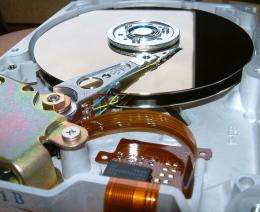
U.S. data storage technologies, like hard-disk drives (HDDs), contain imported rare-Earth elements in their magnets. As the demand for data storage increases, the supply of critical materials will become more limited.
Currently, 20 to 70 million HDDs reach the end of their life every year in the United States. Most are collected from data centers and shredded, which limits the material recovery.
Reusing and recycling HDDs could help preserve high-value materials and reduce environmental impacts, but what options are consumers likely to choose? To identify the most promising circular economy pathways for HDDs, the National Renewable Energy Laboratory (NREL) used agent-based modeling to understand how people decide whether to shred, recycle, or reuse aging disk-drives. Findings, published in a Resources, Conservation & Recycling article, highlight opportunities and challenges for an HDD circular economy.
Agent-based modeling for aging hard-disk drives
Agent-based modeling represents a group of customers as “agents,” or independent decision-making entities that are calibrated based on data to simulate decisions made on behalf of the people they represent.
NREL modeled four agents: HDD end users, initial service providers (like information technology asset disposition companies), recyclers, and manufacturers. Agents choose to reuse, reuse only the magnets inside, shred, or store an aging HDD in different scenarios through 2050. The model also factors in uncertainty, given the lack of existing information about data management. Based on agent decisions, the model calculates mass of recovered materials, economic value, and emissions.
“The modeling approach includes consumers in identifying the best circular economy solution by considering important social elements, like whether end users trust data-wiping technologies used to reuse HDDs,” said Julien Walzberg, NREL analyst and principal investigator of the study.
In a previous study, NREL used agent-based modeling to understand how consumers decide what to do with aging solar panels. A follow-on article in Nature Energy called for all analysis of circular economy strategies to use the agent-based approach to consider social factors.
Reuse over recycling
If today’s trends continue through 2050, the model shows 68% of HDD materials would be recovered from recycling shredded drives. In this scenario, the total mass of recovered rare-earth elements in 2050 is 4.73 thousand metric tons, $12 billion goes into the U.S. economy, and 1.47 million metric tons of CO2 emissions are avoided—the equivalent of more than 4 billion miles driven—compared to 100% shredding with no rare-earth elements recovery.
In the best recycling scenario with the highest material recovery, the total mass of recovered rare-earth elements in 2050 increases to 107,000 metric tons, $6 billion goes into the U.S. economy (less than today’s trends because of no reuse), and 2 million metric tons of CO2 emissions are avoided, or the equivalent of more than 5 billion miles driven.
HDD reuse offers the biggest economic and environmental benefit of any end-of-life option, though, with triple the economic value and more than double the avoided CO2 emissions of the best recycling process. From a literature review, NREL found 60% of old HDDs are still functioning and can be reused as-is, and 95% of the magnets can be recovered intact.
Wiping out data-wiping misconceptions
Reuse of HDDs is dependent on consumer trust of data-wiping technologies. According to the National Security Agency, data-wiped means “permanently destroyed as to make any type of data recovery impossible,” but many consumers still perceive it as a security risk.
If end users in the future decide whether to reuse or shred and recycle HDDs based purely on cost, reuse is more popular because it is cheaper. However, if the norm is a lack of trust in data-wiping technologies, HDD reuse is much lower. If trust has been established among some end users , the reuse rate slowly increases as data-wiping normalizes, suggesting early adopters could set the trend for others.
“While recycling should be the ultimate fate of HDDs, reuse allows HDDs to provide value to the economy for longer,” said Birdie Carpenter, NREL analyst and co-author of the paper. “The modeling also shows reuse has environmental benefits, so it’s important to focus HDDs circular economy strategies on encouraging reuse.”
Consumer trust could improve with better data-wiping standards. In the early adoption phase, wiped HDDs could be sent back to end users to verify that all data was indeed removed. Finally, increasing education and transparency around recycling and data-wiping processes could also encourage early adopters.